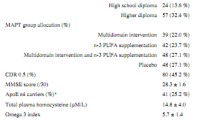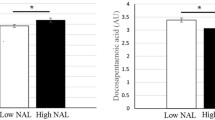Abstract
Objectives
We examined the relationships between erythrocyte membrane monounsaturated fatty acids (MUFAs) and saturated fatty acids (SFAs) and cortical β-amyloid (Aβ) load in older adults reporting subjective memory complaints.
Design
This is a cross-sectional study using data from the Multidomain Alzheimer Preventive Trial (MAPT); a randomised controlled trial.
Setting
French community dwellers aged 70 or over reporting subjective memory complaints, but free from a diagnosis of clinical dementia.
Participants
Participants of this study were 61 individuals from the placebo arm of the MAPT trial with data on erythrocyte membrane fatty acid levels and cortical Aβ load.
Measurements
Cortical-to-cerebellar standard uptake value ratios were assessed using [18F] florbetapir positron emission tomography (PET). Fatty acids were measured in erythrocyte cell membranes using gas chromatography. Associations between erythrocyte membrane MUFAs and SFAs and cortical Aβ load were explored using adjusted multiple linear regression models and were considered significant at p ≤ 0.005 (10 comparisons) after correction for multiple testing.
Results
We found no significant associations between fatty acids and cortical Aβ load using multiple linear regression adjusted for age, sex, education, cognition, PET-scan to clinical assessment interval, PET-scan to blood collection interval and apolipoprotein E (ApoE) status. The association closest to significance was that between erythrocyte membrane stearic acid and Aβ (B-coefficient 0.03, 95 % CI: 0.00,0.05, p = 0.05). This association, although statistically non-significant, appeared to be stronger amongst ApoE ε4 carriers (B-coefficient 0.04, 95 % CI: -0.01,0.09, p = 0.08) compared to ApoE ε4 non-carriers (B-coefficient 0.02, 95 % CI: -0.01,0.05, p = 0.18) in age and sex stratified analysis.
Conclusion
Future research in the form of large longitudinal observational study is needed to validate our findings, particularly regarding the potential association of stearic acid with cortical Aβ.




Similar content being viewed by others
Abbreviations
- AD:
-
Alzheimer’s disease
- APP:
-
amyloid precursor protein
- ApoE:
-
apolipoprotein E
- Aβ:
-
β- amyloid
- CDR:
-
clinical dementia rating
- FAME:
-
Fatty acid methyl esters
- IQR:
-
interquartile range
- PET:
-
positron emission tomography
- PUFAs:
-
polyunsaturated fatty acids
- MAPT:
-
Multidomain Alzheimer Preventive Trial
- MCI:
-
mild cognitive impairment
- MMSE:
-
Mini Mental State Examination
- SFAs:
-
saturated fatty acids
- MUFAs:
-
monounsaturated fatty acids
- SUVRs:
-
standard uptake value ratios
References
Boespflug EL, McNamara RK, Eliassen JC, Schidler MD, Krikorian R. Fish Oil Supplementation Increases Event-Related Posterior Cingulate Activation in Older Adults with Subjective Memory Impairment. J Nutr Health Aging. 2016;20(2):161–9.
Fougère B, Mazzuco S, Spagnolo P, Guyonnet S, Vellas B, Cesari M, et al. Association between the Mediterranean-style Dietary Pattern Score and Physical Performance: Results from TRELONG Study. J Nutr Health Aging. 2016;20(4):415–9.
Lehtisalo J, Lindström J, Ngandu T, Kivipelto M, Ahtiluoto S, Ilanne-Parikka P, et al. Association of Long-Term Dietary Fat Intake, Exercise, and Weight with Later Cognitive Function in the Finnish Diabetes Prevention Study. J Nutr Health Aging. 2016;20(2):146–54.
Limongi F, Noale M, Gesmundo A, Crepaldi G, Maggi S. Adherence to the Mediterranean Diet and All-Cause Mortality Risk in an Elderly Italian Population: Data from the ILSA Study. J Nutr Health Aging. 2017;21(5):505–13.
Oksman M, Iivonen H, Hogyes E, Amtul Z, Penke B, Leenders I, et al. Impact of different saturated fatty acid, polyunsaturated fatty acid and cholesterol containing diets on beta-amyloid accumulation in APP/PS1 transgenic mice. Neurobiol Dis. 2006;23(3):563–72.
Amtul Z, Westaway D, Cechetto DF, Rozmahel RF. Oleic acid ameliorates amyloidosis in cellular and mouse models of Alzheimer’s disease. Brain Pathol Zurich Switz. 2011;21(3):321–9.
Morris MC, Evans DA, Bienias JL, Tangney CC, Bennett DA, Aggarwal N, et al. Dietary fats and the risk of incident Alzheimer disease. Arch Neurol. 2003;60(2):194–200.
Laitinen MH, Ngandu T, Rovio S, Helkala E-L, Uusitalo U, Viitanen M, et al. Fat intake at midlife and risk of dementia and Alzheimer’s disease: a population-based study. Dement Geriatr Cogn Disord. 2006;22(1):99–107.
Eskelinen MH, Ngandu T, Helkala E-L, Tuomilehto J, Nissinen A, Soininen H, et al. Fat intake at midlife and cognitive impairment later in life: a population-based CAIDE study. Int J Geriatr Psychiatry. 2008;23(7):741–7.
Okereke OI, Rosner BA, Kim DH, Kang JH, Cook NR, Manson JE, et al. Dietary fat types and 4-year cognitive change in community-dwelling older women. Ann Neurol. 2012;72(1):124–34.
Hardy JA, Higgins GA. Alzheimer’s disease: the amyloid cascade hypothesis. Science. 1992;10;256(5054):184–5.
Vellas B, Carrie I, Gillette-Guyonnet S, Touchon J, Dantoine T, Dartigues JF, et al. Mapt study: A Multidomain approach for preventing Alzheimer’s disease: Design and baseline data. J Prev Alzheimers Dis. 2014;1(1):13–22.
Del Campo N, Payoux P, Djilali A, Delrieu J, Hoogendijk EO, Rolland Y, et al. Relationship of regional brain β-amyloid to gait speed. Neurology. 2016;5;86(1):36–43.
Joshi AD, Pontecorvo MJ, Clark CM, Carpenter AP, Jennings DL, Sadowsky CH, et al. Performance characteristics of amyloid PET with florbetapir F 18 in patients with alzheimer’s disease and cognitively normal subjects. J Nucl Med Off Publ Soc Nucl Med. 2012;53(3):378–84.
Legrand P, Schmitt B, Mourot J, Catheline D, Chesneau G, Mireaux M, et al. The consumption of food products from linseed-fed animals maintains erythrocyte omega-3 fatty acids in obese humans. Lipids. 2010;45(1):11–9.
Lim GP, Calon F, Morihara T, Yang F, Teter B, Ubeda O, et al. A diet enriched with the omega-3 fatty acid docosahexaenoic acid reduces amyloid burden in an aged Alzheimer mouse model. J Neurosci Off J Soc Neurosci. 2005;23;25(12):3032–40.
Perez SE, Berg BM, Moore KA, He B, Counts SE, Fritz JJ, et al. DHA diet reduces AD pathology in young APPswe/PS1 Delta E9 transgenic mice: possible gender effects. J Neurosci Res. 2010;88(5):1026–40.
Alzheimer’s Association. Alzheimer’s disease facts and figures. Alzheimers Dement J Alzheimers Assoc. 2016;12(4):459–509.
Deyts C, Thinakaran G, Parent AT. APP Receptor? To Be or Not To Be. Trends Pharmacol Sci. 2016;37(5):390–411.
Yang X, Sheng W, Sun GY, Lee JC-M. Effects of fatty acid unsaturation numbers on membrane fluidity and α-secretase-dependent amyloid precursor protein processing. Neurochem Int. 2011;58(3):321–9.
Patil S, Chan C. Palmitic and stearic fatty acids induce Alzheimer-like hyperphosphorylation of tau in primary rat cortical neurons. Neurosci Lett. 2005;26;384(3):288–93.
Goux WJ, Rodriguez S, Sparkman DR. Analysis of the core components of Alzheimer paired helical filaments. A gas chromatography/mass spectrometry characterization of fatty acids, carbohydrates and long-chain bases. FEBS Lett. 1995;5;366(1):81–5.
Heude B, Ducimetière P, Berr C, EVA Study. Cognitive decline and fatty acid composition of erythrocyte membranes—The EVA Study. Am J Clin Nutr. 2003;77(4):803–8.
White B. Dietary fatty acids. Am Fam Physician. 2009;15;80(4):345–50.
Chouinard-Watkins R, Plourde M. Fatty acid metabolism in carriers of apolipoprotein E epsilon 4 allele: is it contributing to higher risk of cognitive decline and coronary heart disease? Nutrients. 2014;6(10):4452–71.
Author information
Authors and Affiliations
Consortia
Corresponding author
Rights and permissions
About this article
Cite this article
Hooper, C., de Souto Barreto, P., Payoux, P. et al. Association of cortical β-amyloid with erythrocyte membrane monounsaturated and saturated fatty acids in older adults at risk of dementia. J Nutr Health Aging 21, 1170–1175 (2017). https://doi.org/10.1007/s12603-017-0975-3
Received:
Accepted:
Published:
Issue Date:
DOI: https://doi.org/10.1007/s12603-017-0975-3




